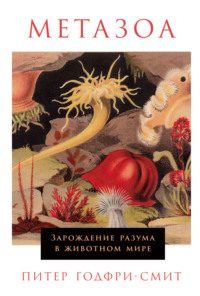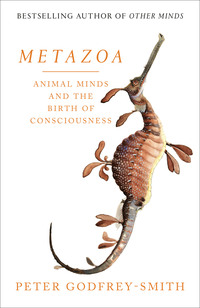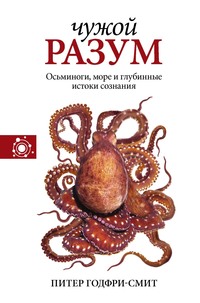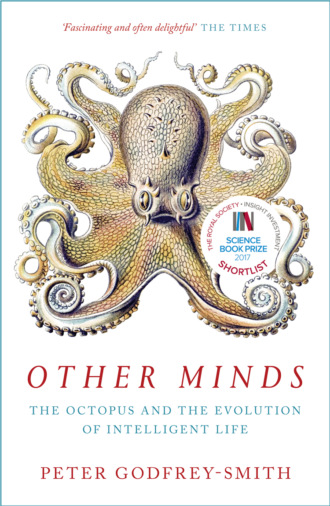
Полная версия
Other Minds: The Octopus and the Evolution of Intelligent Life

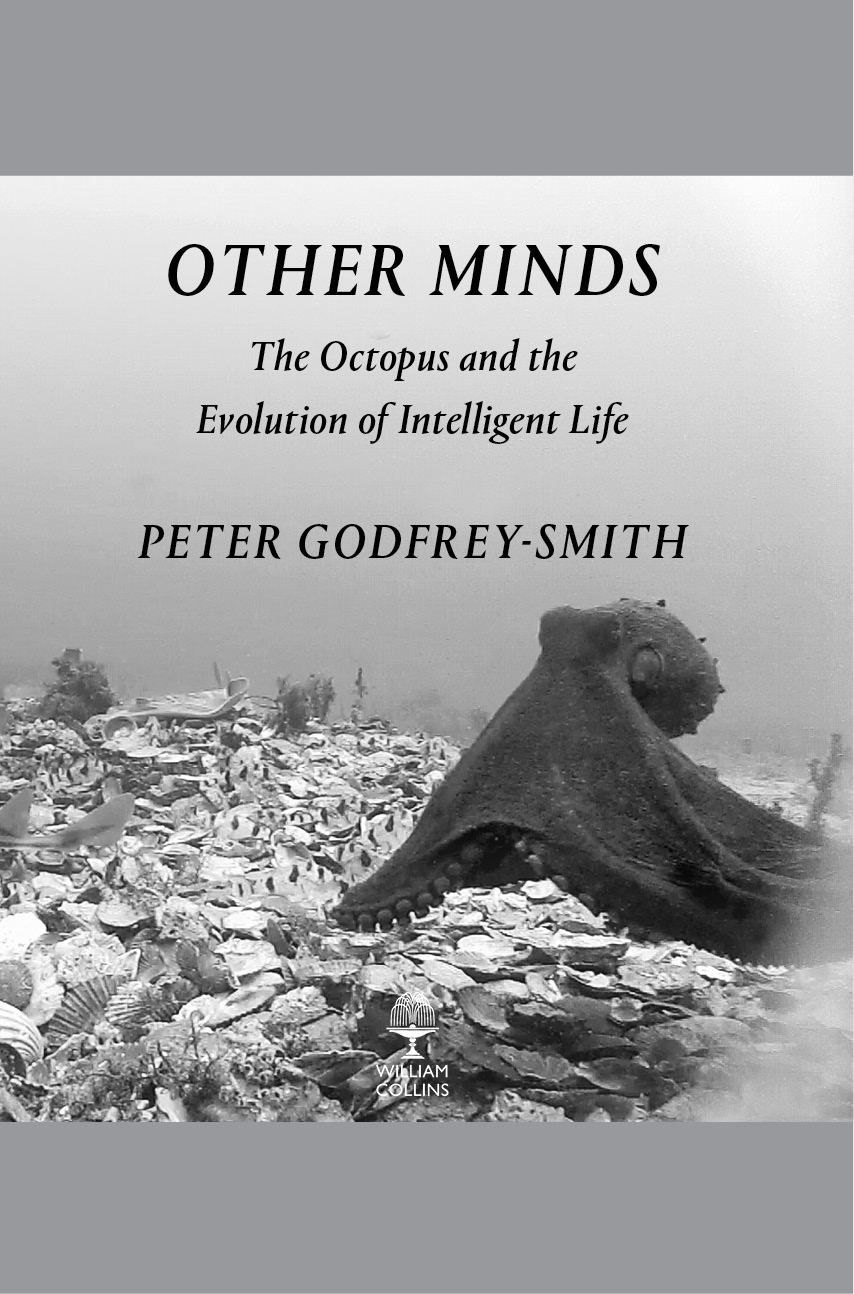
COPYRIGHT
William Collins
An imprint of HarperCollinsPublishers
1 London Bridge Street
London SE1 9GF
WilliamCollinsBooks.com
This eBook first published in Great Britain by William Collins in 2017
First published in the United States of America by Farrar, Straus and Giroux in 2016 as Other Minds: The Octopus, the Sea, and the Deep Origins of Consciousness
Copyright © Peter Godfrey-Smith 2016
An excerpt from Other Minds originally appeared, in slightly different form, in Scientific American.
Cover art: Kunstformen der Natur (1904), plate 54: Gamochonia, Octopus vulgaris by Ernst Haeckel
All photographs were taken by the author, unless otherwise stated
Drawn figures are by the author, unless otherwise stated
Peter Godfrey-Smith asserts the moral right to be identified as the author of this work
A catalogue record for this book is available from the British Library
All rights reserved under International and Pan-American Copyright Conventions. By payment of the required fees, you have been granted the non-exclusive, non-transferable right to access and read the text of this e-book on-screen. No part of this text may be reproduced, transmitted, down-loaded, decompiled, reverse engineered, or stored in or introduced into any information storage and retrieval system, in any form or by any means, whether electronic or mechanical, now known or hereinafter invented, without the express written permission of HarperCollins.
Source ISBN: 9780008226299
Ebook Edition © March 2017 ISBN: 9780008226282
Version: 2018-01-11
DEDICATION
For all those who work to protect the oceans
EPIGRAPH
The demand for continuity has, over large tracts of science, proved itself to possess true prophetic power. We ought therefore ourselves sincerely to try every possible mode of conceiving the dawn of consciousness so that it may not appear equivalent to the irruption into the universe of a new nature, non-existent until then.
– William James, The Principles of Psychology, 1890
The drama of creation, according to the Hawaiian account, is divided into a series of stages … At first the lowly zoophytes and corals come into being, and these are followed by worms and shellfish, each type being declared to conquer and destroy its predecessor, a struggle for existence in which the strongest survive. Parallel with this evolution of animal forms, plant life begins on land and in the sea – at first with the algae, followed by seaweeds and rushes. As type follows type, the accumulating slime of their decay raises the land above the waters, in which, as spectator of all, swims the octopus, the lone survivor from an earlier world.
– Roland Dixon, Oceanic Mythology, 1916
CONTENTS
Cover
Title Page
Copyright
Dedication
Epigraph
1. Meetings Across the Tree of Life
2. A History of Animals
3. Mischief and Craft
4. From White Noise to Consciousness
5. Making Colors
6. Our Minds and Others
7. Experience Compressed
8. Octopolis
Notes
Index
Acknowledgments
Also by Peter Godfrey-Smith
About the Publisher
1
MEETINGS ACROSS THE TREE OF LIFE
Two Meetings and a Departure
On a spring morning in 2009, Matthew Lawrence dropped the anchor of his small boat at a random spot in the middle of a blue ocean bay on the east coast of Australia, and jumped over the side. He swam down on scuba to where the anchor lay, picked it up, and waited. The breeze on the surface nudged the boat, which started to drift, and Matt, holding the anchor, followed.
This bay is well-known for diving, but divers usually visit only a couple of spectacular locations. As the bay is large and typically pretty calm, Matt, a scuba enthusiast who lives nearby, had begun a program of underwater exploration, letting the breeze carry the empty boat around above him until his air ran out and he swam back up the anchor line. On one of these dives, roaming over a flat sandy area scattered with scallops, he came across something unusual. A pile of empty scallop shells – thousands of them – was roughly centered around what looked like a single rock. On the shell bed were about a dozen octopuses, each in a shallow, excavated den. Matt came down and hovered beside them. The octopuses each had a body about the size of a football, or smaller. They sat with their arms tucked away. They were mostly brown-gray, but their colors changed moment by moment. Their eyes were large, and not too dissimilar to human eyes, except for the dark horizontal pupils – like cats’ eyes turned on their side.
The octopuses watched Matt, and also watched one another. Some started roaming around. They’d haul themselves out of their dens and move over the shell bed in an ambling shuffle. Sometimes this elicited no response from others, but occasionally a pair would dissolve into a multi-armed wrestle. The octopuses seemed to be neither friends nor enemies, but in a state of complicated coexistence. As if the scene were not sufficiently strange, many baby sharks, each just six inches or so long, lay quietly on the shells as the octopuses roamed around them.
A couple of years before this I was snorkeling in another bay, in Sydney. This site is full of boulders and reefs. I saw something moving under a ledge – something surprisingly large – and went down to look at it. What I found looked like an octopus attached to a turtle. It had a flat body, a prominent head, and eight arms coming straight from the head. The arms were flexible, with suckers – roughly like octopus arms. Its back was fringed with something that looked like a skirt, a few inches wide and moving gently. The animal seemed to be every color at once – red, gray, blue-green. Patterns came and went in a fraction of a second. Amid the patches of color were veins of silver like glowing power lines. The animal hovered a few inches above the sea floor, and then came forward to look at me. As I had suspected from the surface, this creature was big – about three feet long. The arms roved and wandered, the colors came and went, and the animal moved forward and back.
This animal was a giant cuttlefish. Cuttlefish are relatives of octopuses, but more closely related to squid. Those three – octopuses, cuttlefish, squid – are all members of a group called the cephalopods. The other well-known cephalopods are nautiluses, deep-sea Pacific shellfish which live quite differently from octopuses and their cousins. Octopuses, cuttlefish, and squid have something else in common: their large and complex nervous systems.
I swam down repeatedly, holding my breath, to watch this animal. Soon I was exhausted, but I was also reluctant to stop, as the creature seemed as interested in me as I was in it (in him? in her?). This was my first experience with an aspect of these animals that has never stopped intriguing me: the sense of mutual engagement that one can have with them. They watch you closely, usually maintaining some distance, but often not very much. Occasionally, when I’ve been very close, a giant cuttlefish has reached an arm out, just a few inches, so it touches mine. It’s usually one touch, then no more. Octopuses show a stronger tactile interest. If you sit in front of their den and reach out a hand, they’ll often send out an arm or two, first to explore you, and then – absurdly – to try to haul you into their lair. Often, no doubt, this is an overambitious attempt to turn you into lunch. But it’s been shown that octopuses are also interested in objects that they pretty clearly know they can’t eat.
To understand these meetings between people and cephalopods, we have to go back to an event of the opposite kind: a departure, a moving apart. The departure happened quite some time before the meetings – about 600 million years before. Like the meetings, it involved animals in the ocean. No one knows what the animals in question looked like in any detail, but they perhaps had the form of small, flattened worms. They may have been just millimeters long, perhaps a little larger. They might have swum, might have crawled on the sea floor, or both. They might have had simple eyes, or at least light-sensitive patches, on each side. If so, little else may have defined “head” and “tail.” They did have nervous systems. These might have comprised nets of nerves spread throughout the body, or they might have included some clustering into a tiny brain. What these animals ate, how they lived and reproduced – all are unknown. But they had one feature of great interest from an evolutionary point of view, a feature visible only in retrospect. These creatures were the last common ancestors of yourself and an octopus, of mammals and cephalopods. They’re the “last” common ancestors in the sense of most recent, the last in a line.
The history of animals has the shape of a tree. A single “root” gives rise to a series of branchings as we follow the process forward in time. One species splits into two, and each of those species splits again (if it does not die out first). If a species splits, and both sides survive and split repeatedly, the result may be the evolution of two or more clusters of species, each cluster distinct enough from the others to be picked out with a familiar name – the mammals, the birds. The big differences between animals alive now – between beetles and elephants, for example – originated in tiny insignificant splits of this sort, many millions of years ago. A branching took place and left two new groups of organisms, one on each side, that were initially similar to each other, but evolved independently from that point on.
You should imagine a tree that has an inverted triangular, or conical, shape from far away, and is very irregular inside – something like this:
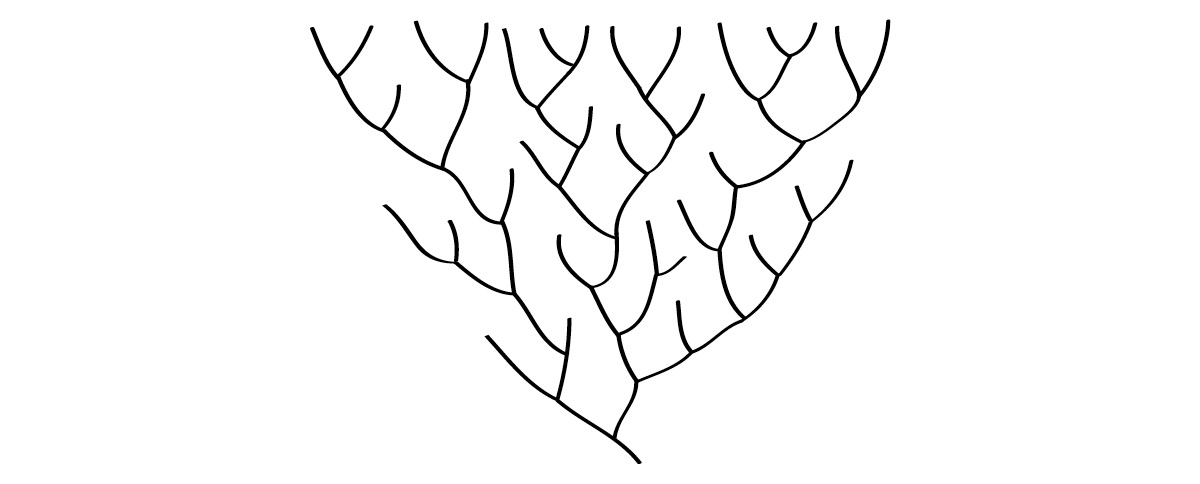
Now imagine sitting on a branch on top of the tree, looking down. You are on the top because you’re alive now (not because you are superior), and around you are all the other organisms alive now. Close to you are your living cousins, such as chimpanzees and cats. Further away, as you look horizontally across the top of the tree, you’ll see animals that are more distantly related. The total “tree of life” also includes plants and bacteria and protozoa, among others, but let’s confine ourselves to the animals. If you now look down the tree, toward the roots, you’ll see your ancestors, both recent ones and those more remote. For any pair of animals alive now (you and a bird, you and a fish, a bird and a fish), we can trace two lines of descent down the tree until they meet in a common ancestor, an ancestor of both. This common ancestor might be encountered just a short way down the tree, or further down. In the case of humans and chimps we reach a common ancestor very quickly, living about six million years ago. For very different pairs of animals – human and beetle – we have to trace the lines further down.
As you sit in the tree, looking across at your near and distant relatives, consider a particular collection of animals, the ones we usually think of as “smart” – the ones with large brains, who are complex and flexible in their behavior. These will certainly include chimps and dolphins, also dogs and cats, along with humans. All these animals are quite near to you on the tree. They are fairly close cousins, from an evolutionary point of view. If we’re doing this exercise properly we should also add birds. One of the most important developments in animal psychology over the last few decades has been the realization of how smart crows and parrots are. Those are not mammals, but they are vertebrates, and hence they are still fairly close to us, though not nearly as close as chimps. Having collected all these birds and mammals, we can ask: What was their most recent common ancestor like, and when did it live? If we look down the tree to where their lines of ancestry all fuse, what do we find living there?
The answer is a lizard-like animal. It lived something like 320 million years ago, a bit before the age of the dinosaurs. This animal had a backbone, was of reasonable size, and was adapted to life on land. It had an architecture similar to our own, with four limbs, a head, and a skeleton. It walked around, used senses similar to ours, and had a well-developed central nervous system.
Now let’s look for the common ancestor that connects this first group of animals, which includes ourselves, to an octopus. To find this animal we have to travel much further down the branches. When we find it, about 600 million years before the present, the animal is that flattened worm-like creature I sketched earlier.
This step back in time is nearly twice as long as the step we took to find the common ancestor of mammals and birds. The human-octopus ancestor lived at a time when no organisms had made it onto land and the largest animals around it might have been sponges and jellyfish (along with some oddities I’ll discuss in the next chapter).
Assume we’ve found this animal, and are now watching the departure, the branching, as it happened. In a murky ocean (on the sea floor, or up in the water column) we’re watching a lot of these worms live, die, and reproduce. For an unknown reason, some split off from the others, and through an accumulation of happenstance changes they start to live differently. In time, their descendants evolve different bodies. The two sides split again and again, and before long we are looking not at two collections of worms, but at two enormous branches of the evolutionary tree.
One path forward from that underwater split leads to our branch of the tree. It leads to vertebrates, among others, and within the vertebrates, to mammals and eventually humans. The other path leads to a great range of invertebrate species, including crabs and bees and their relatives, many kinds of worms, and also the mollusks, the group that includes clams, oysters, and snails. This branch does not contain all the animals commonly known as “invertebrates,” but it does include most of the familiar ones: spiders, centipedes, scallops, moths.
In this branch most of the animals are fairly small, with exceptions, and they also have small nervous systems. Some insects and spiders engage in very complex behavior, especially social behavior, but they still have small nervous systems. That’s how things go in this branch – except for the cephalopods. These are a subgroup within the mollusks, so they are related to clams and snails, but they evolved large nervous systems, and the ability to behave in ways very different from other invertebrates. They did this on an entirely separate evolutionary path from ours.
Cephalopods are an island of mental complexity in the sea of invertebrate animals. Because our most recent common ancestor was so simple and lies so far back, cephalopods are an independent experiment in the evolution of large brains and complex behavior. If we can make contact with cephalopods as sentient beings, it is not because of a shared history, not because of kinship, but because evolution built minds twice over. This is probably the closest we will come to meeting an intelligent alien.
~ Outlines
One of the classic problems of my discipline – philosophy – is the relation between mind and matter. How do sentience, intelligence, and consciousness fit into the physical world? I want to make progress on that problem, vast as it is, in this book. I approach the problem by following an evolutionary road; I want to know how consciousness arose from the raw materials found in living beings. Aeons ago, animals were just one of various unruly clumps of cells that started living together as units in the sea. From there, though, some of them took on a particular lifestyle. They went down a road of mobility and activity, sprouting eyes, antennae, and means to manipulate objects around them. They evolved the creeping of worms, the buzzing of gnats, the global voyages of whales. As part of all this, at some unknown stage, came the evolution of subjective experience. For some animals, there’s something it feels like to be such an animal. There is a self, of some kind, that experiences what goes on.
I am interested in how experience of all kinds evolved, but cephalopods will have special importance in this book. This is firstly because they are such remarkable creatures. If they could talk, they could tell us so much. That is not the only reason they clamber and swim through the book, though. These animals shaped my path through the philosophical problems; following them through the sea, trying to work out what they’re doing, became an important part of my route in. In approaching questions about animal minds, it is easy to be influenced too much by our own case. When we imagine the lives and experiences of simpler animals, we often wind up visualizing scaled-down versions of ourselves. Cephalopods bring us into contact with something very different. How does the world look to them? An octopus’s eye is similar to ours. It is formed like a camera, with an adjustable lens that focuses an image on a retina. The eyes are similar but the brains behind them are different on almost every scale. If we want to understand other minds, the minds of cephalopods are the most other of all.
Philosophy is among the least corporeal of callings. It is, or can be, a purely mental sort of life. It has no equipment that needs managing, no sites or field stations. There’s nothing wrong with that – the same is true of mathematics and poetry. But the bodily side of this project has been an important side. I came across the cephalopods by chance, by spending time in the water. I began following them around, and eventually started thinking about their lives. This project has been much affected by their physical presence and unpredictability. It has also been affected by the myriad practicalities of being underwater – the demands of gear and gases and water pressure, the easing of gravity in the green-blue light. The efforts a human must make to cope with these things reflect differences between life on land and in water, and the sea is the original home of the mind, or at least of its first faint forms.
At the start of this book I placed an epigraph from the philosopher and psychologist William James, writing at the end of the nineteenth century. James wanted to understand how consciousness came to inhabit the universe. He had an evolutionary orientation to the issue, in a broad sense that included not just biological evolution but the evolution of the cosmos as a whole. He thought that we need a theory based on continuities and comprehensible transitions; no sudden entrances or jumps.
Like James, I want to understand the relation between mind and matter, and I assume that a story of gradual development is the story that has to be told. At this point, some might say that we already know the outlines of the story: brains evolve, more neurons are added, some animals become smarter than others, and that’s it. To say that, though, is to refuse to engage with some of the most puzzling questions. What are the earliest and simplest animals that had subjective experience of some kind? Which animals were the first to feel damage, feel it as pain, for example? Does it feel like something to be one of the large-brained cephalopods, or are they just biochemical machines for which all is dark inside? There are two sides to the world that have to fit together somehow, but do not seem to fit together in a way that we presently understand. One is the existence of sensations and other mental processes that are felt by an agent; the other is the world of biology, chemistry, and physics.
Those problems won’t be entirely resolved in this book, but it’s possible to make progress on them by charting the evolution of the senses, bodies, and behavior. Somewhere in that process lies the evolution of the mind. So this is a philosophy book, as well as a book about animals and evolution. That it’s a philosophy book does not place it in some arcane and inaccessible realm. Doing philosophy is largely a matter of trying to put things together, trying to get the pieces of very large puzzles to make some sense. Good philosophy is opportunistic; it uses whatever information and whatever tools look useful. I hope that as the book goes along, it will move in and out of philosophy through seams that you won’t much notice.
The book aims, then, to treat the mind and its evolution, and to do so with some breadth and depth. The breadth involves thinking about different sorts of animals. The depth is depth in time, as the book embraces the long spans and successive regimes in the history of life.
The anthropologist Roland Dixon attributed to the Hawaiians the evolutionary tale I used as my second epigraph: “At first the lowly zoophytes and corals come into being, and these are followed by worms and shellfish, each type being declared to conquer and destroy its predecessor …” The story of successive conquests that Dixon outlines is not how the history really went, and the octopus is not the “lone survivor of an earlier world.” But the octopus does have a special relation to the history of the mind. It is not a survivor but a second expression of what was present before. The octopus is not Ishmael from Moby-Dick, who escaped alone to tell the tale, but a distant relative who came down another line, and who has, consequently, a different tale to tell.
Конец ознакомительного фрагмента.
Текст предоставлен ООО «ЛитРес».
Прочитайте эту книгу целиком, купив полную легальную версию на ЛитРес.
Безопасно оплатить книгу можно банковской картой Visa, MasterCard, Maestro, со счета мобильного телефона, с платежного терминала, в салоне МТС или Связной, через PayPal, WebMoney, Яндекс.Деньги, QIWI Кошелек, бонусными картами или другим удобным Вам способом.





